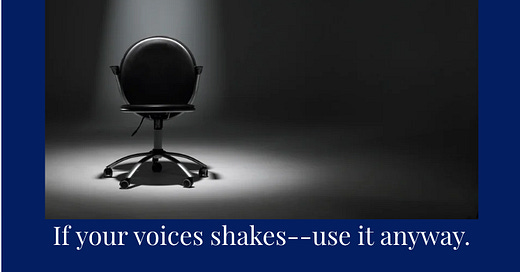Silence isn't neutral—especially for those in positions of leadership, influence, or visibility.
In every room where decisions are made, in every conversation where voices are centered or erased, silence functions as a form of power.
If you’re not naming harm, you're maintaining hierarchy.
If you’re not actively including, you're passively excluding.
Why This Matters in Communication, Leadership, and Power
As someone who advises on communication, leadership, and power, I’ve seen how whiteness often hides behind politeness, objectivity, or "professionalism"—using silence as a tool to avoid responsibility, preserve comfort, and sustain dominance. But here’s the truth: power that refuses to speak honestly is not leadership. Communication that avoids discomfort is not effective. And silence, when harm is happening, is never neutral.
This matters because every leader has a choice: to uphold oppressive systems through inaction, or to dismantle them through truth, humility, and equity-driven communication.
This reflection is a call to make that choice consciously.
The Silence Beneath Whiteness Is “Neutral”
A Reflection, a Disruption, an Invitation to See
We need to talk about the silence beneath whiteness.
Because it often walks into the room wearing politeness, professionalism, or allyship—yet it says nothing when harm is happening. It clutches neutrality like a shield. It whispers, “I didn’t do anything wrong.”
But that’s exactly the point. You didn’t do anything.
And in systems built on white dominance, silence is not passive—it is participation.
What Is the Silence Beneath Whiteness?
This silence is not quiet—it is deeply active.
It is a form of maintenance. It is the mortar in the bricks of white supremacy.
Pause here. Can you remember a time when you witnessed harm—especially racial, ableist, or queerphobic harm—and stayed silent? What stopped you? Whose comfort were you protecting?
How Does Neutrality Show Up in Real Life?
Let’s name some of the most common disguises of white neutrality:
“I didn’t vote for that law, but…” – Legal distance as innocence.
“I don’t get involved in drama.” – Erasure of accountability.
“I support you in spirit.” – Spiritual bypassing without material action.
“Let’s keep this professional.” – Tone policing as harm control.
“I’m still learning.” – Perpetual studenthood as a way to avoid leadership.
“It’s not my place.” – False humility that maintains silence.
These phrases may feel small, even well-meaning. But they act as silencers.
They dismiss, delay, and deflect the truth.
Pause again. Have you ever said one of these things—or heard them in spaces where harm occurred? What did it allow you (or them) to avoid? What did it cost others?
The Myth of Neutrality
Neutrality is not a blank slate. It’s a position of comfort within a structure of oppression.
To be “neutral” when injustice is unfolding is to stand in the shadow of violence and call it shade.
This myth tells white people they’re being "peaceful" when they're being passive.
It tells them they’re being “careful” when they’re being complicit.
Think about a time when you told yourself you were staying “neutral” or “objective.” Who did it serve? Who did it harm?
If You Have to Think of It, You Never Will
The truth is: if people have to “think about” how they’ve upheld whiteness, they often won’t.
Not because they’re incapable—but because whiteness was designed to never have to think of itself. It’s conditioned to see everything else as other.
Which is why we must name it. Reveal it. Disrupt it.
Because if it’s invisible, it remains protected.
If it’s unspoken, it stays unchallenged.
And if it’s unchallenged, it continues to harm.
When was the last time you realized you had missed something because your lens was shaped by whiteness, even if you didn’t intend harm? What did that moment teach you?
This Is Not a Call-Out. It’s a Call-In—with Receipts.
We are not naming this to shame—we are naming it to break the spell.
Silence is not virtue.
Neutrality is not kindness.
Proximity to us is not partnership.
And allyship without risk is not solidarity—it’s cosplay.
We don’t need more performance.
We need transformation. We need power-sharing. We need truth.
So ask yourself—not just today, but every day going forward:
Where am I silent when I should be speaking?
Where am I centered when I should be making room?
Where am I neutral when I should be disrupting?
️
YOUR Call to Action: If You’re Done with Silence —Prove It!
If my words stirred something in you—sit with that.
But don’t let it stop at reflection. Because silence is easy. Action is not. And far too many say they care about justice but stop short when it’s time to fund it, amplify it, or co-create with it.
So ask yourself:
If you say you believe in equity, have you shared or supported Leadership Revealed—a space unapologetically centering women the system overlooks?
If you say you support BIPOC, queer, disabled, and neurodivergent leaders—have you hired, funded, or collaborated with one lately?
If you say you’re about transformation—when will you take the action to work with someone like me?
Don’t just be near our work. Stand in it. Fund it. Learn from it. Collaborate with it.
We don’t need more silent support. We need visible alignment.
Support Leadership Revealed: Yes, here is my support
Contribute to our GoFundMe: (coming this week)
Ready to co-create? Reach out. Let’s make your allyship real.





This is 🎯🎯🎯
The question prompts here are incredibly powerful in inviting us to hold a mirror up to ourselves 🙏🏼🙏🏼🙏🏼